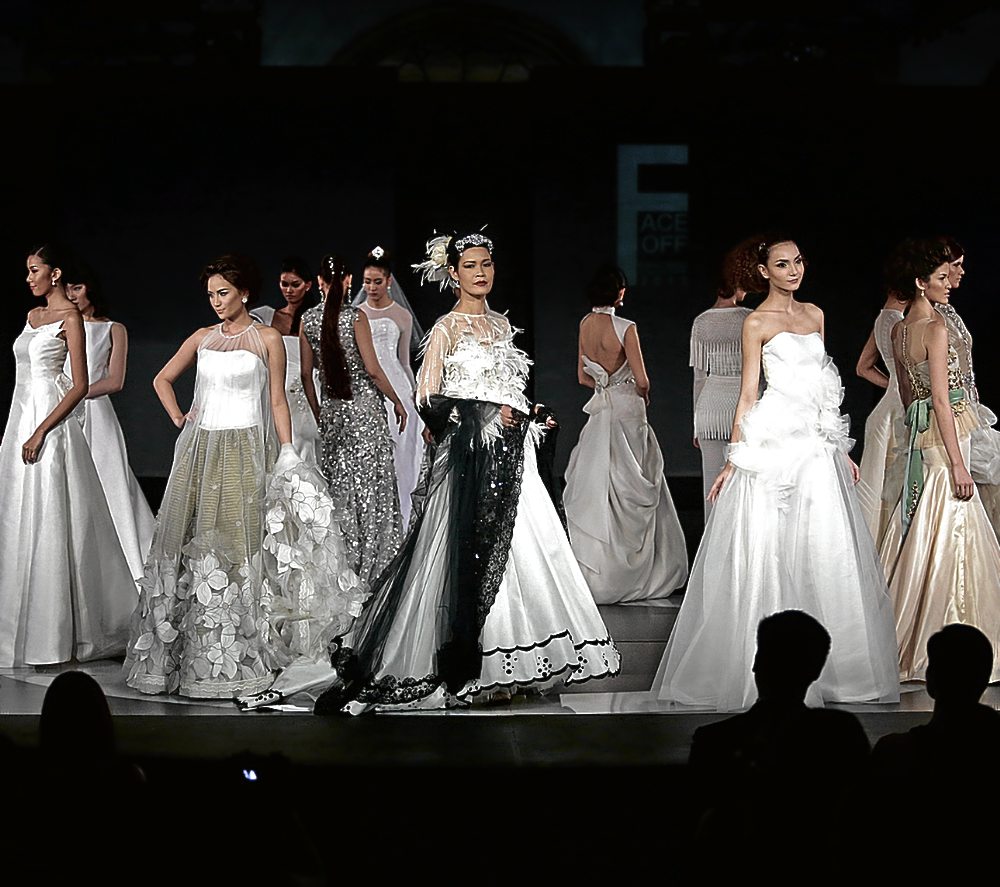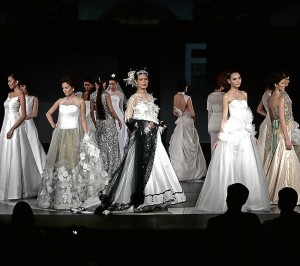 Bridal gowns that were equally elegant and stylish on the aisles as they were on the red carpet seemed to be foremost on the minds of the fashion designers in the Face-Off Filipino Bridal Collection 2012 last Sept. 5 at the Dusit Thani Manila’s grand ballroom.
Bridal gowns that were equally elegant and stylish on the aisles as they were on the red carpet seemed to be foremost on the minds of the fashion designers in the Face-Off Filipino Bridal Collection 2012 last Sept. 5 at the Dusit Thani Manila’s grand ballroom.
Heralding the fashion show was the bridal exhibit sponsored by Champion Infinity, set up in the ballroom foyer. It displayed famous wedding gowns by couturiers in the league of Ben Farrales and Jose “Pitoy” Moreno. Moreno’s wedding gowns for Susan Roces and Mariter Macapagal were on exhibit. (See related story on p.H1)
Organized by Inquirer Lifestyle and Look Magazine, with Samsung, the bridal collection was the biggest show of its kind this year, featuring the bridal designs of 40 designers led by veterans Auggie Cordero, Lulu Tan-Gan, Nolie Hans, Philip Rodriguez, Mike de la Rosa, Efren Ocampo, Loretto Popioco and Gregg Centeno.
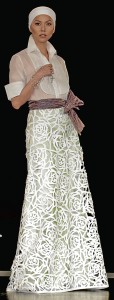
Joining them were younger colleagues such as Randy Ortiz, Rajo Laurel, Cary Santiago, Ivar Aseron, Joey Samson, Noel Crisostomo, Ronaldo Arnaldo, James Reyes, Hindy Weber-Tantoco, Rhett Eala, Jun Escario, JC Buendia, Yvonne Quisumbing, Vic Barba, Patrice Ramos-Diaz, Arcy Gayatin, Oj Hofer, Tonichi Nocom and Dennis Lustico.
The new generation of designers led by Pablo Cabahug, Veejay Floresca, Jerome Lorico, Joel Escober, Jerome Salaya Ang, Kristel Yulo, Chris Diaz, Martin Bautista, Sassa Jimenez, Vania Romoff and Eric de los Santos also held their own.
Crisostomo, for instance, intended his ensemble, consisting of his signature laser-cut faux leather skirt and see-through organdy tuxedo shirt, to be worn again. Apart from adding a mauve gray metallic belt also made of organdy, he lined the white skirt of rose cutouts with mint green silk, to lend color.
“I wanted something feminine, but with a mannish feel to it,” he said. “My muse is Bea Valdes. The look is supposed to be light and easy for a chic, modern bride. That’s why I went for separates. I want her to wear the ensemble again and again, instead of keeping it in its box after wearing it just once.”
Doing away with veils

Many of the designs also did away with veils. Reyes, channeling Audrey Hepburn on her way to afternoon tea, made his model wear a bucket hat of straw and tulle.
“I wanted a fresh and light look so I avoided the usual embellishments and created a contrasting color-blocked gown in duchesse satin,” said Reyes. “I’m loving couture’s current direction. It’s ladylike elegance with a modern edge.”
Ocampo also drew inspiration from Hepburn for what he described as a “slim, sinewy” and strapless number with floral embellishments of guipure lace and organza.
“It’s the complete opposite of the bouffant look,” he said.
Laurel drew heavily from his “sakura experience” last spring in Japan to produce a kimono-inspired silk dress accented by a vintage obi and cord from Kyoto.
“My objective was to draw out a new perspective on bridal that’s modern and fresh to my eyes,” he said. “I’m really in love with Japan and all its nuances.”
Barefoot beauty

Another look that could easily transition from church to ballroom was Tantoco’s sleeveless and sequined tulle number with strings of crystal beads dangling unevenly from the gown’s neckline and skirt.
If you remove the belt and shorten the skirt, the look instantly harks back to the flapper dresses of the Jazz Age.
“I had a barefoot beauty in mind for the dress,” said Tantoco of her champagne-colored creation.
Even Cordero, through his blouse-and-skirt ensemble inspired by portraits of Edwardian-era American artist John Singer Sargent, went for contrast in a white-and-pale ivory number consisting of a vintage satin skirt and point d’esprit top embellished with beads and feathers.
“I used all sorts of feathers, from ostrich to duck, rooster to egret,” he said. “The skirt is semi-bouffant with a scalloped hemline, with each panel adorned with black sequins.”
Instead of a white veil, he used a black lace version worn over a black pillbox hat adorned with huge rhinestones and fine, white feathers.
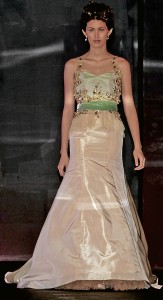
He made a number of tulle cabbage roses, and attached them underneath the skirt to serve as its petticoat. They gave the skirt bounce, said Cordero, without making it look too stiff.
“It was easy to go over the top,” he said. “When you reach a certain age, I think the main challenge for most designers is how to restrain themselves. In my case, I just relied on my craft. Even now, I still manage to learn something new every day.”
Grecian inspiration
Rodriguez, another veteran famous for his dramatic creations, produced a light and almost see-through dress made of jersey and beaded stretched tulle.
The Grecian inspiration was evident, from the draping to the floor-sweeping cape that cascaded from the model’s shoulders. The designer made sure there was no indecent exposure by strategically positioning the jersey material.
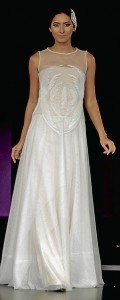
“I was thinking of a destination wedding for this piece,” he said. “I wanted something feminine, sexy, but subtle, light, airy and easy to carry. Once you remove the cape, the gown easily transforms into a party number. Because of its material, it’s easy to pack and requires no ironing.”
De los Santos went for Las Vegas bling with a metallic silver number—inspired, he said, by flowers, glasses and dinner plates. The shiny elements were made of metallic fabric cutouts sewn on illusion tulle. He embellished it further with shiny crystals and stones.
Bucking tradition
Romoff also bucked tradition by eschewing white in favor of a pale blue, Grace Kelly-inspired duchesse satin dress with a top accented with Japanese jusi. Save for a couple of embroidered birds, the huge skirt was free of embellishments.
Fellow young designer Yulo drew inspiration from the fact that she’s getting married herself. The designer got engaged while working on her gown, a serpentine confection of organza, tulle and lace, adorned with paillettes and assorted beads.
“The wedding gowns I work on are the ones I’d be happy to wear myself,” said Yulo. “I think working with different materials and their strengths allow me to highlight the best features of a woman’s body.”
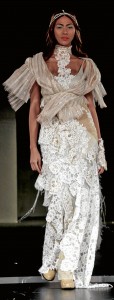
Gayatin shared Yulo’s inspiration. The Cebu-based designer had her bride’s comfort in mind when she produced a sleeveless number that combined tulle and hand-pleated lace. She incorporated blush pearl beading on the bodice to give the dress a hint of color.
“I thought about the dress I’d want to wear if I were getting married just now,” she said. “Beading and pleating by hand posed some challenges.”
Ang had in mind an imaginary woman with a “strong and distinct” personality to produce a body-hugger combining leather cutouts with organdy, duchesse satin and tulle.
“To make it more feminine, I made the skirt semi-flared and gave it some sculptural details,” he said.
Modern twist
Cabahug fused his origami-inspired skirt with his signature tailored and textured top. He chose this direction as a response to today’s brides.
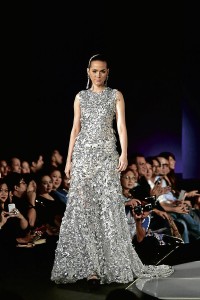
“Many of them want their gowns to be clean, elegant and with a modern twist,” he said. “I used silk cocoon lined with duchesse satin. To give it a vintage touch, I also cut out the embroidery from an old piña barong, and appliquéd it on the gown.”
Escober opted for a slim silhouette, as he derived inspiration from the “classic” and slim flower vase. He decided to “take a different road,” he said, in his bid to provide brides something comfortable without sacrificing fashion.
“I’ve gained a reputation for detailed and frou-frou gowns,” he said. “This time, I decided to celebrate the female form by creating an understated gown made of crepe and satin.”
Like Cordero, (Chris) Diaz also channeled images from paintings. This time, he was inspired by pre-Raphaelite images to produce a strapless column of beige and celadon taffeta, various types of tulle, lace and velvet ribbon.
Eternal bohemian
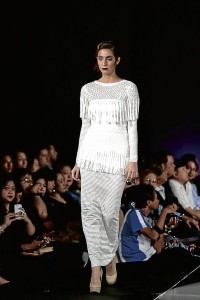
For Tan-Gan, it was the eternal bohemian bride in a column that mixed knitted, woven and lace components. She used French lace draped over a knitted piece made of lurex. To give the look a touch of Filipiniana, the model wore a piña bolero.
Only Cebu-based Cary Santiago went all-out Filipiniana with a duchesse satin, serpentine-shaped terno embellished with pieces of lace strategically cut and positioned on nude lining.
“I wanted the gown to look classic as well as visual,” he said. “I believe I was able to achieve this by using various patterns of lace.”
While Eala and Aseron drew from their respective strengths as designers, Samson, known for his tailored and structured pieces, went the opposite way by working on an unlikely material such as tulle.
“I wanted something very spare, minimal and romantic,” Samson said. “This time, I wanted to show something that’s soft, airy and floaty. To achieve this, I used a little over 100 yards of silk tulle with a grosgrain detail.”
Eala again resorted to hand painting, but went more minimalist by allowing the painting to speak for itself. He also discovered that painting on a fully constructed Mikado silk gown was a painstaking process that allowed him almost no room for error.
“I had to be patient and wait for the paint to dry before painting on more layers,” he said. “It took me a week to paint it completely. The most difficult part was restraining myself since I wanted to make the gown as minimalist as possible.”
Aseron also went the minimal and modern route by taking inspiration from a stack of ladders to produce a pleated number with a floor-sweeping jusi skirt. The challenge, he said, was to still make it look feminine.
Romantic numbers
Barba also went minimalist in his take on classic wedding gowns with a “princess silhouette” using Mikado silk and beaded lace. Except for a big, beaded bow on the back and angular details below the shoulders, the gown was devoid of frou-frou.

Hofer took a different facet of Hepburn for his minimalist tuxedo shirt and A-line skirt combination, which he described as his homage to Holly Golightly. References to Sharon Stone’s oversized men’s Gap shirt-and-skirt ensemble weren’t lost on us.
“A bride should be most comfortable on her wedding day,” said Hofer. “Women shouldn’t be encumbered with too much frou-frou.”
Speaking of classic, the show also had its share of romantic numbers from such designers as De la Rosa, (Patrice) Diaz, Lustico, Centeno, Lorico, Buendia and Arnaldo, as well as classic big, tiered and layered dresses by Escario, Floresca, Popioco and Hans.
De la Rosa was inspired by 1950s Hollywood as envisioned by such fashion gurus as Edith Head—a sinuous and fluid number combining various materials: silk chiffon for the top and silk charmeuse for the skirt. He embellished it at the waist with a series of bows of tulle and organza.
Diaz, who has been on a yearlong sabbatical from made-to-order, was inspired by “vertical gardens,” to produce a strapless A-line made mainly of synthetic fine mesh.
She considered her work a study in manipulating materials, with hand-sewn, bow-like details gathered around the hips and lower bodice.
“I chose this direction because I’m not really out to sell or impress any bride,” she said. “I just wanted to play and have fun by touching and manipulating the material without over-analyzing the concept.”
Postwar English bride
Lustico went ’50s retro, complete with long white gloves and vintage-like beadwork, with his vision of a postwar English bride. The idea, he said, came to him while reading the biography of Diana Mitford Mosley.
“My team and I used silk gazar for the inner dress, which we then embellished with lily-shaped crystals to show the muse’s favorite flower,” he said. “Then we created an oversheath of illusion tulle that draped the bodice.”
Centeno was also inspired by old Hollywood glamour, which he updated by opting for a shorter veil and more contemporary beadwork. He was drawn, he said, to the movement and rustle of silk taffeta combined with stretch tulle.
“I wanted to revive a bygone era for today’s brides,” he said. “I want them to experience the legacy of vintage Hollywood, combined with a modern sensibility.”
Lorico, who first became known as a menswear designer, also chose the romantic route in a slim gown inspired by Shakespeare’s “A Midsummer Night’s Dream.”
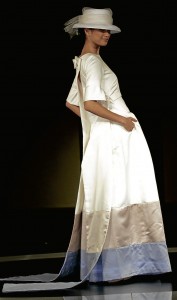
Embellishment, confined mostly to the bodice, consisted of corded lace and crystals. The rest of the gown was fashioned from cotton knit with silver lurex thread for sheen.
As far as Buendia is concerned, romantic doesn’t always mean frilly and complicated. Known for his tailored and minimalist aesthetics, the designer produced another clean, classic number with a Sabrina neckline and low V back made of silk gazar. A small bow held the two back straps together.
Arnaldo also believed the bride should show off her “utmost femininity” on her wedding day. To achieve that, he produced a sleeveless floral-printed wedding gown with a translucent tent-like overlay that doubled as train.
Wearability also guided him, since underneath the overlay was the actual gown, a bustier that could be worn by itself. The ensemble was made primarily of printed organdy and tulle.
“That’s why I put my structural aesthetics to rest this time, and instead focused on the softer side of dressmaking,” he said. “My muse and model is actress Arci Muñoz. I find her a fresh and perfect bride.”
Geometric patterns
Escario played with textures and embroidery on a classic gown with a serpentine silhouette in nude and cream. Apart from aesthetics, he also considered giving the bride her money’s worth.
“I wanted to do something every bride can relate to,” said Escario. “I don’t want to give her another showpiece that she’d end up keeping in storage.”
Hans had a bride in her early 20s in mind for his show-stopping dress with a slim, strapless bodice and huge skirt. He did away with beadwork, and instead embellished the skirt with strips of illusion tulle in geometric patterns.
“I used 150 yards of fine illusion tulle for the skirt,” he said. “To emphasize my imaginary young bride’s sweet face, I reembroidered the French lace on the veil.”
Finally, Floresca, one of the best talents of his generation, also went the other way by going maximalist with impressive results. Inspired by 1940s glamour, the ecru number he created was huge, ruffled and tiered, but somehow managed to look light, easy and tidy.
“I wanted to achieve a soft, classic and elegant look,” said Floresca. “To achieve my vision, I used such materials as soft tulle for the skirt and duchesse satin for the bodice, which also had a sheer beaded neckline. The hardest part was creating something that would stand out and, at the same time, speak of my aesthetic as a designer.”
Visit the author’s blog at alexyvergara.wordpress.com.

